
But first… a refresh
If we thought Daimler pulled out the stops communicating the new Actros, Arocs, and Fuso’s journey to this part of the world, the Freightliner Cascadia showed it was merely warming up.
On numbers sold, the Cascadia must surely rank as one of the most successful modern highway trucks ever built, and its launch Down Under is certainly a big thing.
In mid-2019, Australasian journos were allowed to document the truck’s preparation for its journey south first-hand in the United States.
We were exposed to the inner workings of design, development and production at Daimler’s US HQ in Swan Island, Oregon; the high-altitude testing ground at Madras about three hours up the road; the Detroit Diesel engine plant in Detroit, Michigan; and finally, to where our new Cascadias will be born, the assembly facility in Charlotte North Carolina (New Zealand Trucking magazine, September and October 2019).
Then came the official Antipodean ribbon-cutting in Sydney two years ago this month, with the highest-powered delegation of Daimler dignitaries ever seen at any swanky ‘barbie’ in these parts (New Zealand Trucking magazine, Feb 2020).
All that must have been a big expense for sure, but it was peanuts compared with the cost of getting the trucks ready for an ANZAC assault, with zero change from AU$100 million (about NZ$105 million), according to Daimler Australia CEO Daniel Whitehead.
It was also infinitesimal in importance compared with the real backstory that was going on, the one they wanted us all fully briefed on.
At the top of the Daimler food chain the decision had been made to have a sort-out of the company’s regional structure in our neck of the woods.
South Africans would now fall under the care of Daimler Europe. The Anzacs would be looked after by Daimler Trucks North America (DTNA).
That means we now benefit from the gargantuan might of DTNA’s product research and development machine, and it also meant we got the Cascadia.
While for some, that might induce a starry-eyed ‘wow!’, it also meant the end of our old mate, the Freightliner Argosy.
For many a resident in the smallest country affected by the rejig, namely us, that news induced a throwing of toys from the odd cot for obvious VDAM reasons.
It’s sad that the last-ever example of a greenfield US cabover truck found its happiest home in a wee country that couldn’t ensure its survival.
It’s a bit like being given the last remaining brontosaurus and only a single cabbage to keep it alive. Eventually, you will need a big hole.
Like it or not, much of what comes our way does so due to our ANZAC mates over the drain.
Were they not there, New Zealand would be a very different country and what swung us in the direction of DTNA’s keep was a regional new-truck market with a US share of 20%-plus (total sales somewhere about 14,500).
In other words, the size of the pie. With New Zealanders comprising 0.49 of 1% of the DTNA market’s human population, and only marginally more in respect to the trucks, you could say our ability to steer developmental direction is … limited.
Suffice to say once the reshuffle was signed off, the Argosy was buggered (Aussie never warmed to it, anyway), and for us, Daimler’s cabover strategy took on a Volvo- esque platform flavour… You know, if you want a cabover Mack, it’s called a Volvo, and now if you want a cabover Freightliner, it’s called a Mercedes-Benz Actros or Arocs.
Look at me now

Fifty years ago, a bonneted US truck was all about the power train – huge bonnets with a little shed tacked on the back for the driver to sit in and work the ‘reins’ and ‘whip’, keeping all those horses up front in trim.
 The design of early modern trucks was in many ways a metaphorical evolution of the stagecoach, sitting up high, looking out over the power unit.
The design of early modern trucks was in many ways a metaphorical evolution of the stagecoach, sitting up high, looking out over the power unit.
Truck drivers were lucky, though. In time, they were allowed to sit in a fully enclosed ever-more waterproof tin shed, with an increasing level of amenity – heaters even. Over time, the needle has shifted almost 180 degrees, especially in the on-highway sector.
Now, an approaching Freightliner Cascadia, International ProStar, and T410/610 Kenworth are more like an approaching cab with a bonnet of sorts hanging off the front.
The 2020 Cascadia 116 is probably the extreme member of that industry subset.
There’s nothing wrong with Cascadia’s looks for its industry genre, nothing at all.
In fact, we found the 116 very photogenic, never taking a bad Polaroid at all.
 Yet its appearance is certainly dominated by the cabin area.
Yet its appearance is certainly dominated by the cabin area.
That visual impact of the shed is softened somewhat on its bigger brother, the 126, on account of having to house the bigger banger out front.
The latest version of the truck received a new grille; the notched horizontal bars might not be to everyone’s taste but, hey, we’re all different.
It’s shiny and polishable, so that’s a plus … for some. See what I mean?
Much of the development work for the journey south involved FUPS adaptation and inclusion, fuel tank straps, and battery box mounts.
If you look at the front of a 2020 stateside example, nothing sets it apart, so Freightliner’s cosmetic surgeons have done well.
The roots of Cascadia’s Goliath-like position in the US Class-8 market today is largely the work of Martin Daum.
Things were a bit ‘doldrumy’ when he arrived in 2009 as the new boss at DTNA, so he set lofty developmental goals for the truck, seeking a 5% reduction in TCO (Total Cost of Ownership) every two years.
Today, Cascadia accounts for just less than 40% of its market.
Maybe the success of that strategy had some contribution to his current perch, CEO Daimler Truck AG… (Ya think?).
Stateside, nothing’s changed, but it’s difficult to know what sort of wash from that mandate will arrive here.
I’m sure everyone buying a Cassy in Godzown would love a 5% reduction in TCO bi-annually, but realistically, that’s unlikely.
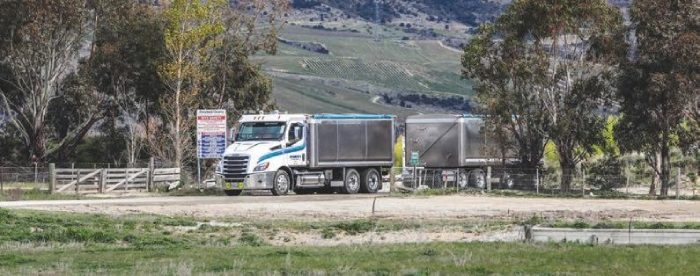
As you can imagine, aerodynamics is a really big thing in the US, and many of the early gains were created there.
Then, advanced safety systems rose to the surface – the reason Cascadia’s Detroit Assurance-5 system is lineball with the latest from Mercedes-Benz – and when we were there in 2019, down- speeding was a hot topic, as was propulsion in general (FYI, ‘down-speeding’ is not going slower, it’s giving it longer and longer legs for low-rpm cruise).
Then there’s ever more evolved fleet-maintenance programmes, and in time you’ll likely see some form of OEM distribution and even supply-chain management offerings also.
It seems to be the way the big boys’ world is heading.
But rest assured, we’ll give the aero guys at Swan Island a hernia with essentials such as bull bars in New Zealand, twin stacks, and all the other good stuff. We’ll keep it real… for a time, at least.
Spring in Cromwell
In life, there are times when your inner self tells you that some things just shouldn’t be.
Standing on Rogers Street in Cromwell, on a clear spring morning, we’re looking into the yard of McNulty’s Transport, and there ‘looking’ back at us is a Freightliner Cascadia.
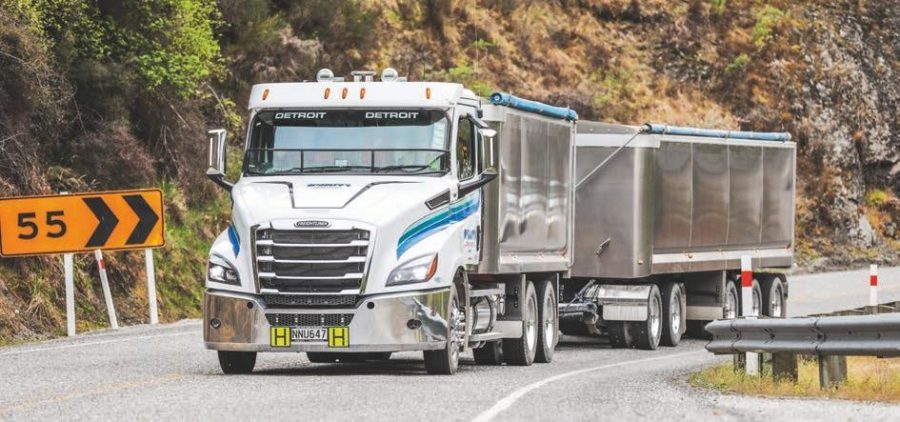
It has an element of penguins-in-the-Arctic about it. The US is where you see Freightliner’s most successful endeavour.
But Cromwell? Who’d have thought? Just then, owner Brian McNulty appears. “G’day boys. There she is. Spike’s here somewhere, down the back, I think. So is Brad, the driver. Come with me, let’s go for a walk.”
Of course, If you’re a South Island trucking propeller head, you’ll know ‘Spike’ is well- known McNulty’s operations manager Brett Tomkies.
Down behind the concrete batching plant near a big shed, we find a group of blokes sorting sides, tailgates, and things, a scene that’s likely repeating itself in transport yards all over the county at this time of day.
There’s a big round of ‘G’days’, handshakes, and a bit of a yarn, before we’re heading for our truck of the moment with driver, 28-year- old Brad McKee.
Brad’s been with the company for three months, and has driven the Cascadia for its 23,000km life to date.
 We jump into the cab and pull on the door. It shuts with a dense airtight thud, something we are well used to in a Cascadia from time spent stateside, but not something the average Freightliner punter here will find familiar.
We jump into the cab and pull on the door. It shuts with a dense airtight thud, something we are well used to in a Cascadia from time spent stateside, but not something the average Freightliner punter here will find familiar.
Brad dips the clutch, selects his gear, and we pull out onto Rogers Street to deliver last night’s on-cart.
We always knew this day was coming, and we’d seen a Cascadia as far south as Sydney, obviously.
But the past two years have indeed been interminable. Yet instantly, here was the real deal, doing real work in New Zealand.
No demo or evaluation unit, a proper purchased truck, expected to earn an honest dollar for its no-nonsense owner for many a year.
All the things we were familiarised with at the Madras test facility 28 months ago were back front of mind; the vision, the left/right clearance, the mirrors, and the soundness of the build.
Of course, to this point, we’d been the beneficiaries of only ‘ra-ra’ positivity from all corners of the DTNA and Daimler Australia camps.
There were no downsides to Cascadia by all accounts, and to be fair, we’d found them an easy and comfortable truck to drive.
That made Brad’s less than enthusiastic opening comment a wake-up call on the realities of day-to-day work.
“There’s just no reference point on that bonnet. In fact, there’s no bonnet. You just have to learn how to judge it and remember it’s there at all.” He was right on all counts.
Meandering out through Rogers Street and down McNulty Road (yes, they even have a street named after them…How famous is that?), the bonnet was merely a thin white meniscus along the bottom of the vast single- piece windshield.
Maybe not so bad thundering along the open highway, but in other circumstances? Yes, well, you’ll see in a minute where we’re going here.
Mountains, to mountains, to sea
As we said in the opening, Cascadia was named after the Cascade mountains of Oregon.

The Madras proving ground on the high plateaux of the inner state was where we first got behind the tiller of a Cascadia, so it’s cool that our first Kiwi encounter is in Central Otago.
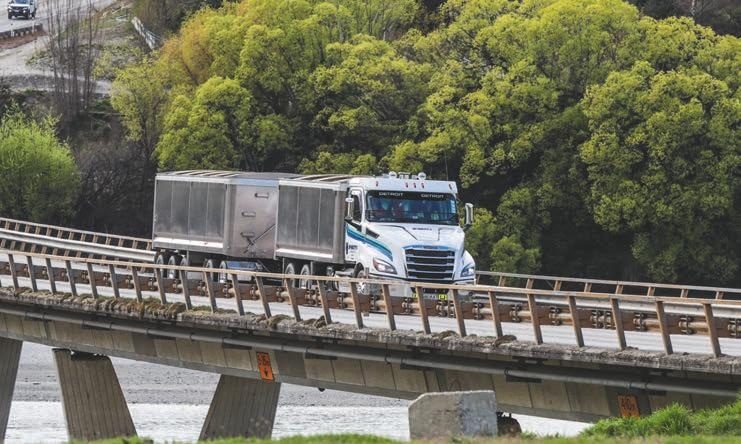
If you imagine a world-class truck-test complex in the middle of the MacKenzie Country, you’re pretty much there in terms of the location and surroundings of the Madras facility.
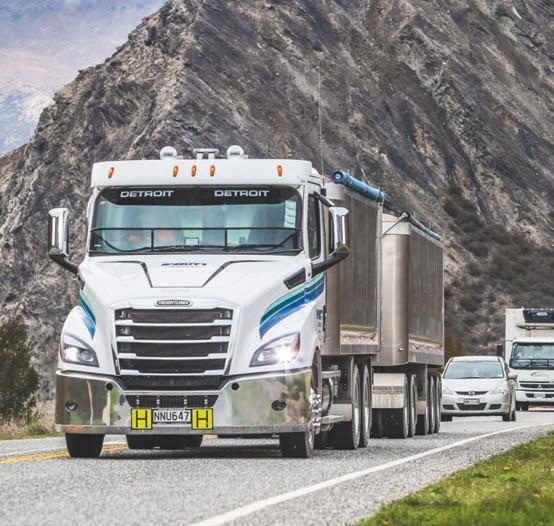
The MacKenzie is postcard size by comparison, of course…Everything in the US is bigger. Our load was aggregate from McNulty’s Amisfiled Quarry, opposite Mount Pisa on SH6, about a quarter distance between Cromwell and Wanaka.
Brad had loaded the night before, and we were bound for a regular drop- off point, the Firth concrete plant on Glenda Drive in Queenstown.
Supplying the Firth plants in Queenstown and Wanaka makes up the bulk of the work done by the Cascadia and the company’s 4864 Western Star, which you’ll remember was the Top Truck in the February 2020 issue.
Another member of Daimler’s house, it’s now done more than 330,000km and is still kept in showroom nick by driver Brendan Savage.
It’s not all backwards and forwards, though.
There is occasional outwork and runs to the East Coast to deliver and pick up aggregates and other quarried material.

It’s all to do with unique regional geologies and the rocks that come from them, some being good for this and others for that.
You don’t get to 143 years in the transport game without being savvy, and the McNulty’s crew are no slugs when it comes to budling trucks and trailers fit for purpose.
“It’s pretty much all shorthaul. You’re trying to keep two busy concrete plants stocked, plus our own, so the less trips you have to do and the more you can put on, the better,” says Brian.
The new addition will cart 32 tonnes of product on eight axles at 48-tonne HPMV, which sounds great, but Brian remembers the company’s first MBE-powered Columbia bulky carting 31 tonne on seven axles at 45-tonne GCM.
“We can run three tonne heavier, yet only cart one tonne more,” he laughs.
“Agh! It’s just how it is today. Extra axles, compliance, and all the exhaust shit. It all adds up.”
The Cascadia was spec’d for the Firth supply job, and that’s what the bulk of its life will entail. In the 116 model, the truck runs the Detroit Diesel DD13, 13-litre diesel burner with GHG17 US emissions via EGR and SCR, which is even a notch more planet-friendly than Euro-6.

In the McNulty truck, output is set at 351kW (470hp) and 2237Nm (1650lb/ft).
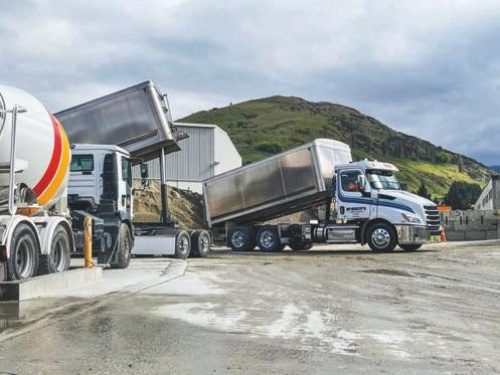
That’s a modest performance spec by today’s standard, and just to note, you can get the DD13 up to 377kW (505hp) and 2508Nm (1850lb/ft) also.
“We don’t need that power for what we do,” says Brian. “There’s only one hill between here and Queenstown and none between here and Wanaka. The occasional run out to the coast is nothing in the bigger scheme of things.”
Similar to all modern engines, though, it’s how the performance is delivered that’s the key.
The torque curve is flat from 975rpm, would you believe, and when the lines meet at 1500rpm, both key numbers are so close to their respective peaks as to make no difference.
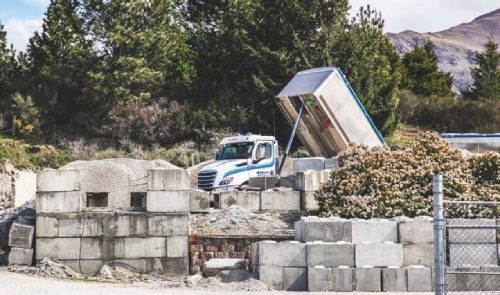
Power achieves its ultimate high point just up the needle at 1625rpm. Behind the motor is an Eaton Roadranger RTLO16918B 18-speed manual transmission.
Upfront, a Meritor FG941 axle at 6300kg rating sits on taper leaf parabolic springs and shock absorbers. Way out back, Meritor MT40- 14XGP with full cross-locks at 18,600kg capacity ride on AirLiner 40,000lb air suspension with dual levelling valves.
Fitted with drum brakes, the McNulty’s Cascadia has EBS, ABS, and all that it needs to run HPMV, but it’s not spec’d with the Detroit Assurance-5 safety pack.
Obviously, there’s cruise control and the usual garb, but no adaptive, lane departure or side keep etc.
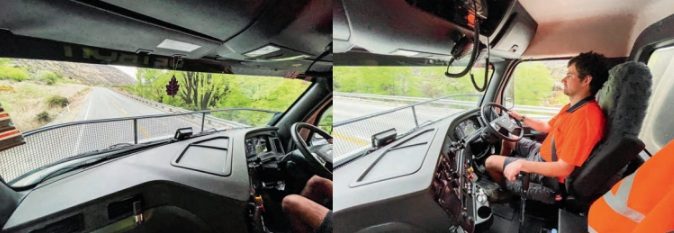
Here and there, then here again
Brad points the Cascadia into the Kawarau Gorge, a 25km-odd stretch of the 57km run from Amisfield to Frankton on the outskirts of Q’town.
The gorge links the Clutha Valley to Queenstown and beyond, tracking the Kawarau River through the Gibbston Valley.

It’s all scenic splendour, yet another roading horror. But once used to its foibles, it’s all in a day’s work.
It’s a bit narrow and windy in some places and dippy and ‘uppy’ in others. Then there are bits that look fine and tighten up, and others that look nasty yet roll benignly under the truck’s wheels.
The biggest thing on this stretch is the comforting knowledge that most motorists on it with you aren’t paying the least bit of attention to the act of driving.
Why would you when there’s that scenery to look at or a bungy jump to watch? Even more snuggly is the realisation that amid the region’s economic boom, now well into decade three, the good old government doesn’t appear to give a Covid-filled cough about improving the state of the region’s key transport modality so that it might keep pace with what’s happening around it.
 Care and maintenance through the gorge take the form of large splotches of black bitumen over potholes.
Care and maintenance through the gorge take the form of large splotches of black bitumen over potholes.
I guess the take-home is that SH6 Kawarau Gorge is likely to remain the way it is for a while yet.
Given the awful carriageway, the Cascadia’s rubber front and rear air suspended cab gave us a lovely ride.
Obviously, the data collected from the field test units in 2018/19 was on point.
The truck sat flat through the corners and absorbed the bumps and slumps admirably.
Directionally, it was a point and shoot affair with the Cascadia going exactly where Brad pointed it. As you’d expect, all controls fall into easy reach.
There’s no question this is a road the McNulty boys know well. “Sometimes, you’ll be on all Queenstown, but often there’ll be a mix of Queentowns and Wanakas. We share it around. Then you get the odd away trip to the coast, so it works out okay really.”
By now, we’re passing Roaring Meg power station, a historic site that McNulty’s actually carted product to when it was built.
The climb away from here is the biggest pull on the job, maybe a kilometer long in total and takin to, say, the lower western Kaimais at its worst. Elands on the Napier-Taupo maybe? And it’s not a hill you can get a run at.
Rounding the bottom corner by the powerhouse and over the ‘pinchy’ bridge, you’re into a gutsy pull that varies in grade all the way up. The Cascadia made quite short work of it, droppingto 30km/h, 1400rpm, in fifth direct.
From there, it descends away down and around some rocky outcrops, and the Jacobs was strong and able to keep proceedings in check, with only a little help from its friends (Brad and the footbrake).
If you read last month’s celebration of the Jake’s birthday, this was a perfect example of a modern iteration. The rock walls of the Gibbston Valley certainly weren’t crumbling in the resonance generated by the Jacobs’ boom.
Yes, it got a little more audible in the cab – about 74dB, but we didn’t resort to handwritten
signs to communicate. While we are on the topic, cruising at 1300rpm and 90km/h was about 70dB.
The next marker was the wee nip up onto Pleasant Flats from the Kawarau River crossing as the road exits the gorge at the Queenstown end.
It’s steeper than Meg, but way shorter, barely 400m in all reality, and here Brad demonstrated the Cascadia’s lugging ability, letting it run back to 20km/h at 1000rpm, again in fifth direct.

Daimler has put a great deal into the low-end performance of the DD13 and 16 motors to get the most from fuel use and down-speed running in the vast tracts of the US.
The benefit for us was a motor that sounded incredibly comfortable at low rpm.
Pleasant Flats further vindicated Brian and Spike’s spec on the truck, meaning at full weight, it’ll still hold high range on the steepest pinch of its most common job.
You know also that performance is only going one way as she frees up too.
Anyone who has added Euro-6 trucks to their fleet will likely be aware the bar for fuel consumption has been reset to the good.
The McNulty Cascadia looks to align itself well to that trend. Granted, it’s a 50% loader most of the time, but given the short- haul, stop-start nature of the truck’s usual workload, add the ‘horribleness’ of the Kawarau Gorge, plus the fact she’s 24,000km new, we thought 2.05kpl (5.70mpg) out of the box was exceptional.
And again, when you think all but a few trucks improve with age, the prognosis looks better than promising.
Tip of the day
Truck drivers’ book of life, fact 4352. Nowhere in Queenstown has any room.
 Firth is no exception. Brad threaded his way in along Glenda Drive and turned up what looked like anything but an entrance to a concrete batching and dispatch plant.
Firth is no exception. Brad threaded his way in along Glenda Drive and turned up what looked like anything but an entrance to a concrete batching and dispatch plant.
“It gets quite tight in here [No shit?], especially if their trucks are all in. Wanaka is much better.”
If there was ever a time the Cascadia’s invisible bonnet was a huge benefit, this was it . as long as you knew where it was, that is. Once upon a time, a 470hp rigid US truck with a bonnet, in a place like this, would have been as maneuverable as an Italian nonna in a budget motel shower.
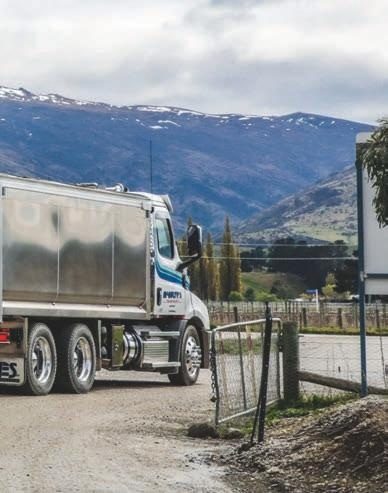
In 2021, the Cascadia’s nimbleness in Brad’s hands belied the size of the payload it delivered, probably 25% more than its 1980s forbears.
The MAN mixer truck on the wash obstructed the available workspace already in short supply as Brad backed the TES five-axle trailer into the bin as smooth as silk.
Up went the hoist, and out came the sand. Cool as a cucumber, he jack-knifed the trolly around the front of the MAN mixer and poked the truck into the aggregate bin he was after. Again, up and out.
Walking around the trucks that morning with Brian, we commented on the prevalence of the TES bodies and trailers.
“Yep, Keisty [Stephen Keist – TES] builds a bloody good product at a fair price. He’s our preferred supplier absolutely, and he stands behind what he builds. If there’s a problem, he’ll fix it, no issues.”
Watching Brad punt the Cascadia around the yard, we thought it time to see where Freightliner’s finest fits in the battle of the snub noses.
Bumper-to-back-of- cab for the 116 is 2970mm (116 inches). By comparison, ProStar is 2895, and the T410 and T610 2850. Western Star’s 4800 series is still the snubbiest at 2271mm, although bear in mind, its cab is the most dated and old-school in terms of depth.
Bumper-to-front-axle-centres are: Cascadia 1315mm, Pro 1295mm, the K’Dub Brothers 1240mm, and the Star’s front axle is set forward, so never mind.
Where to now?
Breaking free of the Queenstown chaos, the run home empty is a doddle. The Amisfield quarry is a vast open area, out of sight of the road.
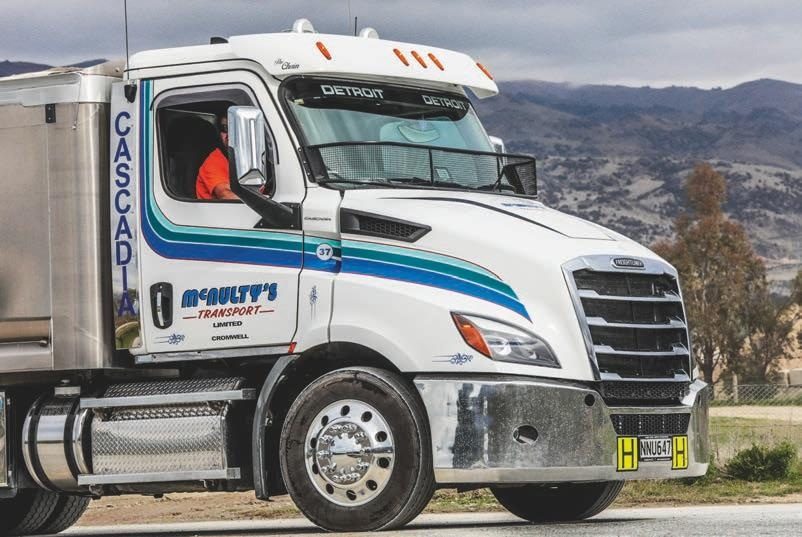
They seemed a cheery bunch of guys and gals on the loaders, and in no time, we were climbing our way out of the pit.
“It’s as cruisy as hell,” said Brad. “There are no dockets, it’s all electronic.”
A couple more into Queenstown, and then an afternoon run to Wanaka. There’s certainly a difference in the two, with far less frenzy-infused traffic on the way, more spread out, no hills, and a user-friendlier delivery point at the Ballantyne Road facility.
We’ve said in previous scribbles that Cascadia would suit a ‘bulky’ with its torpedo nose running up the cab and along the bin lines. It certainly looks sleek. For obvious reasons Cascadia won’t reach the same dizzy heights of market share here as it does back home, and it’s limited potential may be even more boutique than originally thought.
In mid 2019, Daimler Australia boss Daniel Whitehead was talking-up the potential of an 8×4; but by the Sydney launch, Global truck and bus boss Martin Daum had cooled right off, going as far as saying 8×4 was a vocational thing and therefore more in the Western Star’s box of tricks.
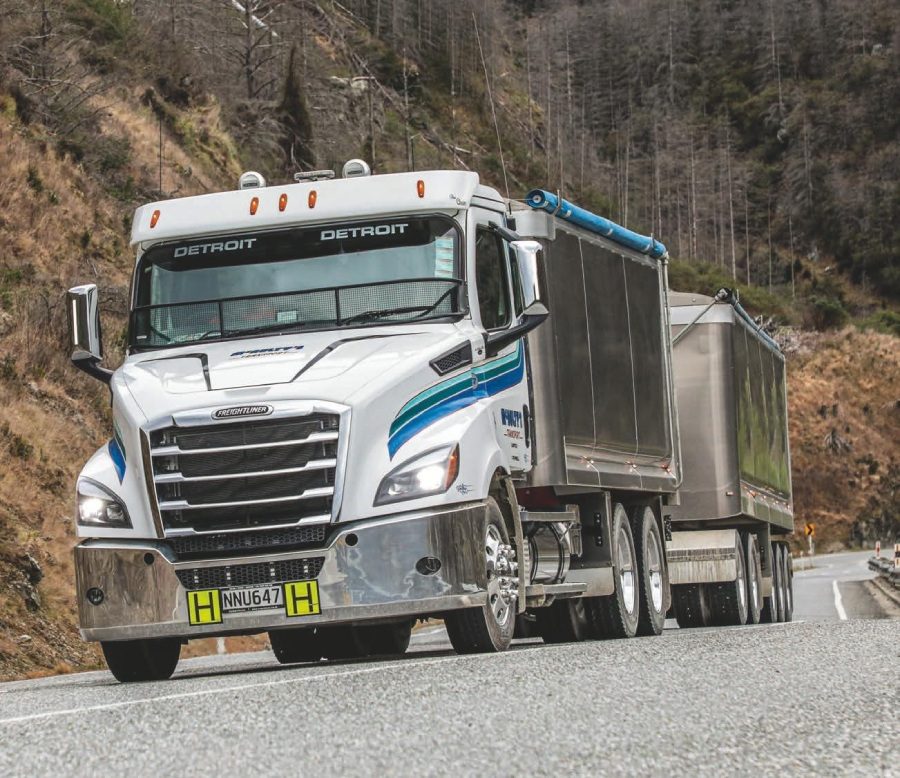
Maybe 49X will be Daimler’s ultimate platform Kiwi conqueror.
The McNulty Cascadia is the first of two coming to the company. This one, No.37, is called ‘The Chain’, a song from Brian’s favourite group Fleetwood Mac. The next one will be ‘Little Lies’. Brian laughs.
“I swore I’d never buy an auto but the next one’s coming with the AMT, and all the safety fruit too, so it had to be Little Lies really. It’ll go under one of the cement tankers and run out to the coast every day. Mechanicals-wise, it’s identical – engine, back end and all that.”
What a fascinating prospect that will be. It’ll be worth touching base in a year or two for a beer and comparison. McNulty’s has a long history with the Freightliner brand.
Their work profile means they are a payload chaser, so it’s understandable Freightliner would make the radar blip.
Over the years, they’ve had Columbia, Century Class, and Argosy all working across the spectre of fleet operations.
“My first Columbia, an MBE-powered truck on cement, was a brilliant truck,” says Brian. “The second one on tip work, not so great. Trevor’s been good, and they’ve been supported.
“I bought these because you just couldn’t not. Half a million kilometres free servicing and a 1,000,000km warranty on the major components. It’s a no brainer.”
Brian likes to turn the trucks over around the 700,000- mark which should mean a trouble-free life. DTNA says the DD13 and 16 have a B50 life of 1,600,000km, meaning half of all engines made should run that distance without needing major repair or overhaul. Whether that number’s tweaked for us and the Ockers, who knows? Likewise, the fault per vehicle per year KPI. When we were in the States, the director of vehicle durability and reliability for DTNA, Napolyon Isikbay, told us the new truck was running at less than 1.1. Again, US stats, not ours.
In the US there are all sorts of options around fleet management, servicing programmes, and the almost endless potential with Detroit Connect communications to and from the truck. DTNA can update these things on the fly, it’s that hooked into the mothership.
“The trucks come with a complementary ‘Best Basic’ five-year service plan, and there’s the ‘Complete’ programme based on cents per kilometre. Australia is currently in the process of getting Detroit Connect to New Zealand,” said Trevor McCallum, Cable Price brand manager for Freightliner.
Nowhere to run – summary
It’s here, and it’s good. It was always going to be. We may not have chosen a swanky tech-fest for our first Cascadia, but we did choose a well thought-out and well- spec’d one.
 On the power front, it needs nothing more than what it has, and for the times it does motor off somewhere else, it’ll be better than fine. Forty-odd years ago, 470hp would have given you a place at the bar among the biggest, hairiest, we completed two days with ease, in comfort.
On the power front, it needs nothing more than what it has, and for the times it does motor off somewhere else, it’ll be better than fine. Forty-odd years ago, 470hp would have given you a place at the bar among the biggest, hairiest, we completed two days with ease, in comfort.
Aside from a limited market for the bonneted 6×4 configuration in New Zealand, Cascadia’s ultimate success will be in the support it receives, allowing every truck sold to live up to its US reputation.
You don’t sell 150,000 of a new model off the bat when they’re shitters. US operators aren’t dumb. DTNA is among designing, evaluating, building, and selling trucks, and it’s done its homework before giving us its golden child.
That means if Cascadia is anything less than an outright success in its somewhat specific market Down Under, the fault will be in our backyards, be it here or Melbourne. Nowhere else.
Read more
The right man for the job
0 Comments29 Minutes
Legendary ambition
0 Comments36 Minutes
Hard Fought!
0 Comments40 Minutes
Postal Trifecta
0 Comments29 Minutes





